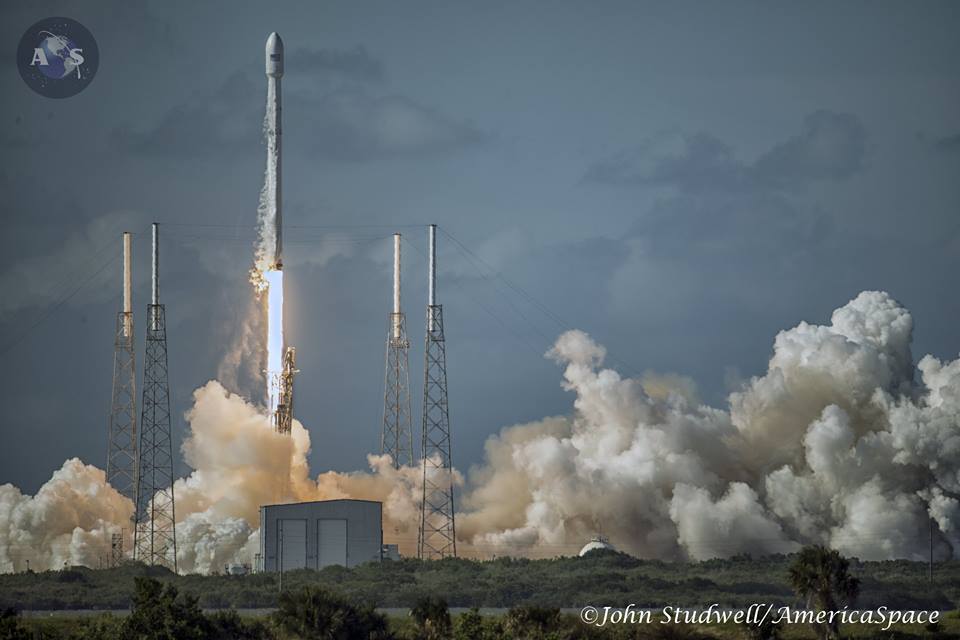
SpaceX successfully delivered the 25th member of its workhorse Falcon 9 booster family aloft tonight (Friday, 27 May). After passing through an apparently flawless countdown on Thursday afternoon, the process of fueling the Upgraded Falcon 9 with liquid oxygen and a highly refined form of rocket-grade kerosene (known as “RP-1”)—which should have gotten underway at T-35 minutes—was delayed and the 5:40 p.m. EDT opening of the two-hour launch window was missed. Amid a characteristic dearth of information from SpaceX, a revised T-0 of 7:36 p.m. EDT was eventually issued, but at length a 24-hour scrub was announced and efforts set in motion for another attempt on Friday.
In spite of initial fears that the weather would dip to just 60-percent-favorable, conditions actually proved beautiful and the Upgraded Falcon 9 roared aloft from Space Launch Complex (SLC)-40 at Cape Canaveral Air Force Station, Fla., at 5:39 p.m. EDT Friday, right on the opening of the launch window. Nine minutes later, the first stage completed a perfect landing on the Autonomous Spaceport Drone Ship (ASDS) in the Atlantic Ocean and at 6:11 p.m. SpaceX deployed its tenth payload towards an eventual Geostationary Transfer Orbit (GTO) destination, more than 22,300 miles (35,900 km) above Earth.
As outlined in AmericaSpace’s Thaicom 8 preview article, this mission represents the quarter-century flight by a member of SpaceX’s Falcon 9 fleet. First launched in June 2010, the fleet saw five missions in its v1.0 variant, before signing-off in March 2013, after which 15 flights were executed by the enhanced v1.1 between September 2013 and January 2016. Then, last December, the current configuration—the Upgraded Falcon 9, boasting structural enhancements to its airframe, “densified” cryogenic propellants and an improved Merlin 1D+ engine suite—undertook its maiden voyage and has now flown five times. Only one mission by a member of the Falcon 9 family has succumbed to total failure. Last June, the second-to-last v1.1 was lost near the end of first-stage flight, when it suffered a catastrophic overpressure incident in its second-stage liquid oxygen tank.
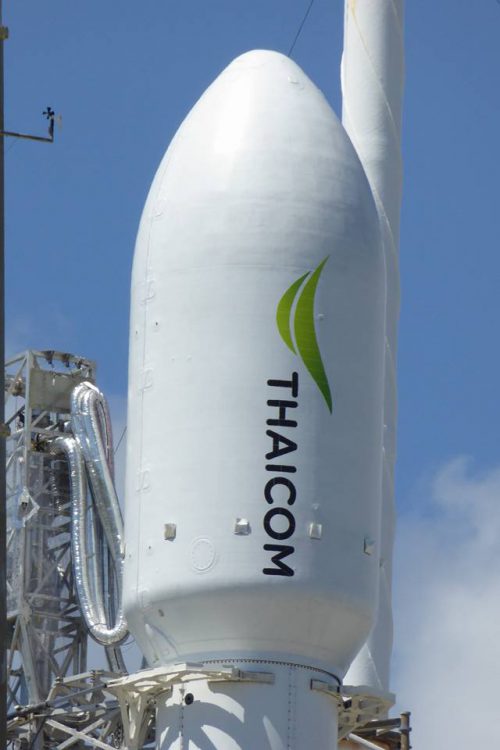
Tonight’s flight was the third time that SpaceX has hosted a payload to be utilized by the Bangkok-headquartered Thaicom satellite services company. In January 2014—on only its second foray to geosynchronous altitude—a Falcon 9 v1.1 deliver Thaicom 6 perfectly to its desired location. Eight months later, another v1.1 lofted AsiaSat 6 (half of whose 28 transponders were marketed as “Thaicom 7”) to geosynchronous orbit. And between those two launches, in the spring of 2014, Thaicom announced its intention to deliver Thaicom 8 aboard a SpaceX vehicle in the first half of 2016. Two months ahead of schedule, prime contractor Orbital ATK delivered the 7,330-pound (3,325 kg) satellite in late April, where it was fueled and encapsulated within the bulbous Upgraded Falcon 9 Payload Fairing (PLF). A Static Fire Test of the nine Merlin 1D+ engines of the booster’s first stage was conducted on Tuesday, 24 May, clearing a final critical milestone before launch.
As detailed by the 45th Weather Squadron at Patrick Air Force Base in its standard L-1 briefing, meteorological conditions were expected to be near-perfect, throughout tonight’s two-hour “launch window”. Moderate temperatures helped to temper the risk of coastal showers on Thursday morning, although the situation is expected to deteriorate towards the weekend, with an anticipated formation of disturbed weather east of the Bahamas. “On launch day, the main weather concern will be liftoff winds,” it was noted on Tuesday morning. “Maximum upper-level winds will be from the northwest at 25 knots at 40,000 feet.” All told, this generated a 90-percent likelihood of acceptable weather at T-0.
Launch Attempt 1: Thursday, 26 May
Unlike its predecessors, the v1.0 and v1.1, the fueling regime for the 229-foot-tall (70-meter) Upgraded Falcon 9 is significantly truncated, chiefly due to the late loading of its densified cryogenic propellants, which begins at T-35 minutes. “The countdown appears to be running smoothly,” explained AmericaSpace’s Launch Tracker, shortly before 4 p.m. EDT Thursday. “Over the past few hours, the engineers have been checking out systems both on-board the rocket, the payload and the Ground Systems. All of the main activity is crammed into the last 35 minutes of the countdown, when the fast-fueling commences as the countdown heads towards the automated Terminal Count at T-10 minutes.”
As Thursday dawned, SpaceX teams came to their consoles to begin countdown operations, which progressed smoothly into the afternoon hours. At 5:02 p.m. EDT, about 38 minutes before the opening of the two-hour launch window, the SpaceX Launch Director was expected to poll his team for a “Go/No-Go” decision to begin propellant tanking, but this did not occur. “Launch team finalizing review of vehicle data and check outs,” SpaceX tweeted at 5:18 p.m. “Will move T-0 into the two-hour window.”
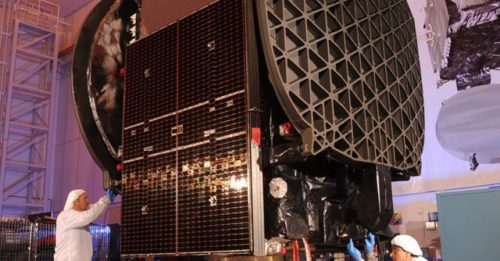
Although a launch at the opening of the window was preferable, its expansive nature allowed mission teams the relative luxury to adjust T-0 to a point anywhere within the two hours. However, with Thursday’s window due to close at 7:40 p.m., and with 35 minutes required to fuel the Upgraded Falcon 9, a delay to the onset of fueling beyond 7:05 p.m. EDT would force an automatic scrub for the day and a 24-hour turnaround to Friday. “There is no word yet as to what issues are being worked,” admitted AmericaSpace’s Launch Tracker at 5:27 p.m., “or indeed if anything is.”
Characteristically, no word emerged from SpaceX during this time. However, observers at the Cape—including AmericaSpace’s imagery team—spotted the typical plume of liquid oxygen vapor from the booster, indicative that tanking was underway. “For this to be underway, either they have already set a new T-0 or there is a problem that was identified after fueling started,” our Launch Tracker explained at 5:49 p.m. “With the new supercold propellants, they can only be tanked and maintained for a short period of time, before they start to warm up and the rocket engines would not be able to perform to rated thrust.”
Shortly thereafter, it was confirmed that SpaceX was tracking a revised T-0 at 7:36 p.m., just four minutes before the closure of Thursday’s window. By this stage, a scrub seemed likely and at 6:43 p.m. SpaceX confirmed a 24-hour scrub. Friday’s launch attempt, also running for two hours, extended from 5:39 p.m. through 7:39 p.m. “Out of an abundance of caution,” the company tweeted, “launch postponed until no earlier than tomorrow for addtl data review”. It subsequently became clear that a glitch had been detected in the motion of a second-stage engine actuator. “Probably not a flight risk, but still worth investigating,” SpaceX revealed, adding that both the Upgraded Falcon 9 and Thaicom 8 remained in a healthy configuration at SLC-40.
Launch Attempt 2: Friday, 27 May
However, a 24-hour turnaround brought a significant change of fortune with respect to weather suitability. An area of disturbed weather, which formed to the north-east of the Bahamas, threatened to slowly strengthen and begin destabilizing the atmosphere over the Space Coast. In addition to the already extant likelihood of exceeding limits on Liftoff Winds, this also posed the risk of violating the Thick Cloud Rule and Cumulus Cloud Rule. The 45th Weather Squadron therefore predicted a 60-percent probability of acceptable weather for Friday’s launch attempt, with conditions dropping still further to just 50-percent-favorable in the event of another delay to Saturday, as the risk of lightning also came into play.
Notwithstanding this initially pessimistic outlook, the weather situation at the Cape appeared bright, though windy, as SpaceX teams pressed into their second launch attempt. “Rocket now being fueled and Launch Director confirms Go for launch,” SpaceX tweeted at 5:04 p.m. Friday, as the countdown entered its final 35 minutes before the opening of the window. This positive news was accompanied by a steadily improving weather situation, which by 5:30 p.m. had risen to 80-percent-favorable, with a potential risk of violating the Cumulus Cloud Rule.
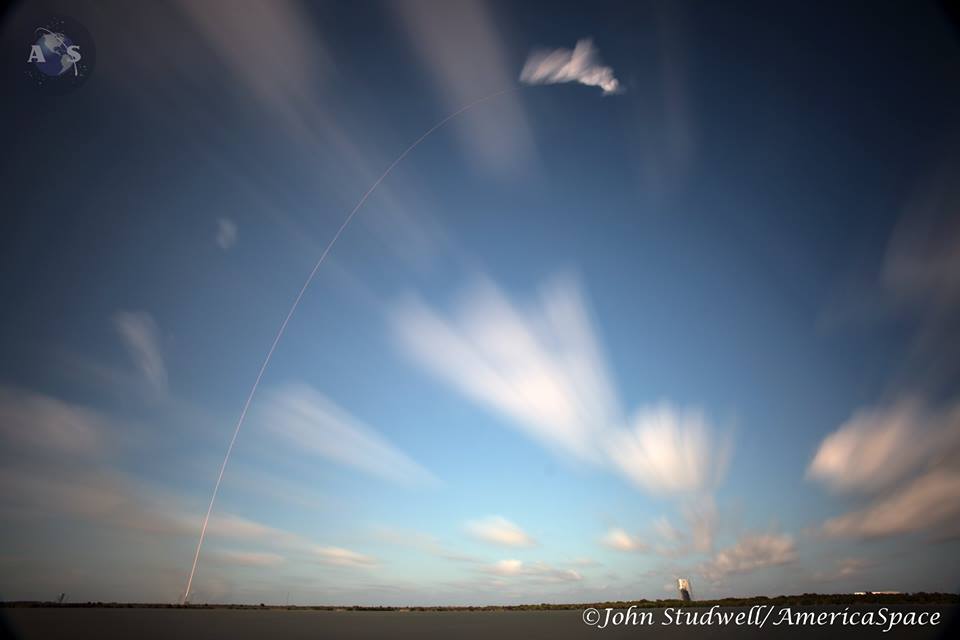
Reaching T-13 minutes, a final “Go/No-Go” poll of all 13 flight controllers was undertaken, yielding a unanimous string of “Go” calls across the board. This enabled the Launch Director to authorize the beginning of the Terminal Count at T-10 minutes, during which time the nine Merlin 1D+ engines of the first stage were chilled, ahead of their ignition sequence. All external power utilities from the Ground Support Equipment (GSE) were disconnected, the Thaicom 8 payload was transitioned to internal battery power and, at T-5 minutes, the roughly 90-second process to retract the “strongback” from the Upgraded Falcon 9 got underway.
In tandem, the Flight Termination System (FTS)—tasked with destroying the vehicle in the event of an accident during ascent—was placed onto internal power and armed. Fueling concluded and the first-stage propellant tanks reached their proper flight pressures. The Merlins were purged with gaseous nitrogen and, at T-60 seconds, the “Niagara” deluge system of 53 nozzles was activated, flooding the launch pad and flame trench with 30,000 gallons (113,500 liters) of water per minute to suppress acoustic energy radiating from the engines. At the same time, the rocket entered “Startup”, with its on-board flight computers in command of all critical vehicle functions.
At T-3 seconds, the Merlin 1D+ engines roared to life, ramping up to their combined thrust of 1.5 million pounds (680,000 kg). Following computer-commanded health checks of the engines, the vehicle was released from SLC-40 and the booster blazed into the Florida sky at 5:39 p.m. EDT. Immediately after clearing the tower, the booster executed a combined pitch, roll and yaw program maneuver, establishing itself onto the proper flight azimuth to inject Thaicom 8 into Super-Synchronous Transfer Orbit (SSTO), somewhat higher than its eventual Geostationary Earth Orbit (GEO). After separation, the satellite would employ its own thrusters to reduce its orbital altitude to about 22,250 miles (35,800 km).
Eighty seconds into the climb, the Upgraded Falcon 9 exceeded the speed of sound and experienced a period of maximum aerodynamic duress—colloquially known as “Max Q”—on its airframe. Concurrently, the Merlin 1D+ Vacuum engine of the second stage underwent a “chill-down” protocol, prior to its own pair of “burns,” late in the ascent, to deliver Thaicom 8 to orbit. About 2.5 minutes after liftoff, the first stage shut down and separated, with the Merlin 1D+ Vacuum engine igniting a few seconds later and generating 210,000 pounds (95,250 kg) of thrust. During the course of its first burn, which lasted a little over six minutes, the two-piece (or “bisector”) Payload Fairing was jettisoned, by means of a pair of pneumatic “pushers”. This exposed Thaicom 8 to the space environment for the first time. The combo then coasted for more than 18 minutes, ahead of the second burn at 6:06 p.m. EDT.
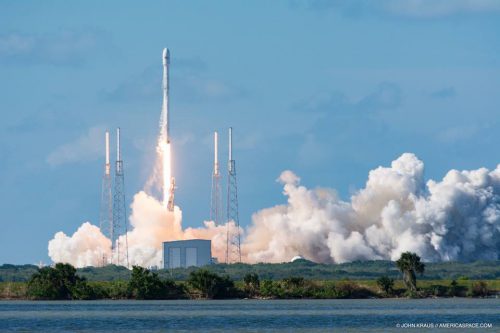
This burn was much shorter than its predecessor—running for barely 70 seconds or so—but by the time of its conclusion Thaicom 8 had been correctly positioned for transfer to GTO. The satellite was released from the second stage at 6:11 p.m., about 32 minutes after departing the shores of Cape Canaveral, and could be seen drifting off into the inky blackness. After several weeks of checkout, it will be co-located with the Thaicom 5 communications satellite at 78.5 degrees East longitude, supporting Ultra-High-Definition Television (UHDTV) demands across Thailand, South Asia and Africa.
As the second stage and Thaicom 8 continued on their voyage, the first stage was concluding its own journey, back towards the Atlantic Ocean and a soft-landing on the deck of the ASDS. All four previous Upgraded Falcon launches attempted landings, either on solid ground or on the deck of the drone ship, but SpaceX has long stressed that the high-energy and high-velocity demands of the GTO ascent profile makes it harder to secure success. “Droneship landing challenging,” SpaceX tweeted earlier this week. “Very hot and fast first-stage re-entry.” The greater energy requirement to get their heavyweight payloads to altitudes of more than 22,300 miles (35,900 km) invariably means that there is less available propellant to support a series of burns to bring the first stage back through the atmosphere and achieve a precise landing. In March, the first stage from the SES-9 launch reached the deck of the ASDS, but was lost on impact, whilst the returning booster from 6 May’s JCSat-14 launch succeeded in touching down intact, but reportedly sustained “max damage”.
In Thaicom 8’s case—as with SES-9 and JCSat-14—the returning first stage was heading for the ASDS, affectionately nicknamed “Of Course I Still Love You”, situated about 420 miles (680 km) off Cape Canaveral. Following separation from the rest of the Upgraded Falcon 9, the first stage executed an approximately 20-second “Re-Entry Burn”, to adjust its impact point, reduce its velocity and ease the stresses on its airframe as it returned from the edge of space. This allowed the proper conditions to be met for a final “Landing Burn” onto the ASDS deck at just 4.5 mph (7.2 km/h). Touchdown occurred at 5:48 p.m., a mere nine minutes since leaving the Cape.
“Falcon 9 second stage and Thaicom 8 spacecraft in nominal orbit and coast,” SpaceX tweeted at 5:51 p.m. “First stage has landed on the drone ship.” And indeed it had. “SpaceX have come a long way in the science of reusable rockets,” noted AmericaSpace’s Mike Barrett on our Launch Tracker. “This despite the potential difficulties of the boosters returning from flight profiles for GEO insertion.” Early images from SpaceX showed that the blackened and scorched first stage had come almost dead-center onto the large “X” on the ASDS deck.
Almost immediately, the congratulations began flooding in. “Amazing every time I see it!” exulted Canadian Space Agency (CSA) astronaut Jeremy Hansen, whilst veteran shuttle and International Space Station (ISS) flier Garrett Reisman—who now serves as SpaceX’s Director of Crew Operations—added his own unique blend of humor: “Man, what are we going to do with all these rockets?” And, not to be left outdone, the ASDS itself was represented via the Twitter handle, @TheDroneShip, which noted: “It’s like I’m not even trying anymore!” As of this moment, SpaceX has four Upgraded Falcon 9 booster cores—and a total of 36 Merlin 1D+ rocket engines—back in its inventory, for potential refurbishment and future reuse.
Want to keep up-to-date with all things space? Be sure to “Like” AmericaSpace on Facebook and follow us on Twitter: @AmericaSpace
Missions » Commercial Space » Thaicom » Thaicom-8 »



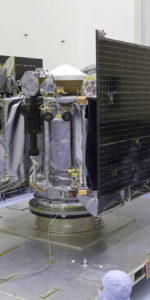

The F-9FT looks very powerful. Congrats to SpaceX on a successful launch and S1 landing.
It’s no hobby rocket.
Triggers fired!
Great Article…
Joe…shouldn’t we have heard by now if the first stages returned are truly ready for reuse by now?